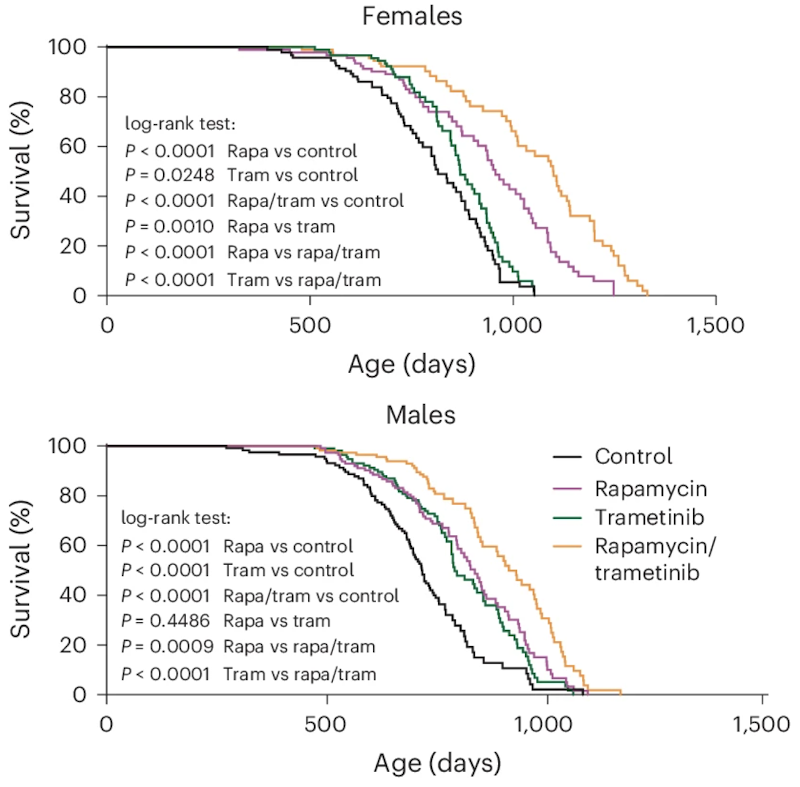Combining rapamycin with the anti-cancer drug trametinib produced a synergistic effect and robust life extension in a new study [1].
A multi-node approach
Rapamycin, which was first widely used as an immunosuppressant for transplant patients and is also used in oncology, is considered one of the most powerful geroprotectors. In the “gold standard” Interventions Testing Program (ITP) trial, rapamycin increased median lifespan in mice by 23% for males and 26% for females [2].
Rapamycin works by inhibiting mTOR, a key regulator of nutrient sensing. Very broadly, rapamycin treatment reroutes the body’s resources from growth to maintenance, including by increasing autophagy, the process of intracellular junk disposal.
mTOR is part of a bigger nutrient sensing network, and a growing number of studies indicate that affecting other nodes in this network might create a synergistic effect with rapamycin. Previous successes include a combination of rapamycin and the anti-diabetes drug acarbose, which increased median lifespan by 28% for females and by 34% for males [2].
We reported on this study last year, when it was published as a preprint. Now, peer-reviewed and published in Nature Aging, it is worth revisiting. This study reports on a combination of rapamycin and trametinib, another oncology drug that inhibits the nutrient-sensing Ras/MEK/ERK pathway, which is upregulated in many cancers. Co-authored by the renowned geroscientist Linda Partridge of the UCL Institute of Healthy Aging and the Max Planck Institute for Biology of Aging, this study had a large sample size and included extensive phenotypic and histological testing.
The researchers had 100-120 mice of each sex in each one of the four arms (control, rapamycin only, trametinib only, and combination) for a total of 800+ animals. The treatment started at the age of 6 months. While trametinib treatment was continuous, the mice only received rapamycin every other week, as previous research indicates it’s safer and just as effective as continuous administration.
The combo reigns supreme
Trametinib treatment alone caused a mild but statistically significant increase in median lifespan of 7% for females and 10% for males. This is the first study to establish this drug as a lifespan extender in mice, although previous research showed effectiveness in other animal models such as Drosophila flies. Interestingly, the drug caused a massive 16% increase in maximal lifespan in male mice but not in females.
Rapamycin performed as expected, while the combination produced the biggest effect, increasing median lifespan by 35% in females and 27% in males along with maximal lifespan by 32% in females and 26% in males. Maximal lifespan was measured as the point in time when only 10% of the mice remain alive.
“While we do not expect a similar extension to human lifespans as we found in mice,” said Linda Partridge, “we hope that the drugs we’re investigating could help people to stay healthy and disease-free for longer late in life. Further research in humans in years to come will help us to elucidate how these drugs may be useful to people, and who might be able to benefit.”

Improved healthspan and cancer burden
The combination treatment also improved various functional outcomes. Rapamycin alone, and even more so the combo, kept the heart’s electrical timing youthful by averting the usual QT-interval stretch in males, while trametinib helped slow the age-related drop in resting heart rate. All treatments nudged older male mice to burn a little more fat at night with an improved respiratory exchange ratio. The combination treatment had a considerable effect on inflammation by lowering the levels of pro-inflammatory cytokines and the number of activated microglia, pro-inflammatory immune cells, in the brain.
Cancer is a major cause of death in lab mice. Since both drugs are used in oncology, the researchers wanted to know whether the pro-longevity effect was mostly due to cancer reduction. Only the combination treatment significantly lowered liver and splenic tumor prevalence (35% to 45% compared to at least 60% in controls), suggesting that reduced cancer burden accounted for part of the added lifespan. Yet, most combo-treated mice still died of cancer and their survival advantage remained when cancer deaths were excluded from the analysis. This means that other benefits must also be at play.
Rapamycin has known side effects, which include increased blood glucose (hyperglycemia), increased liver fat (lipidosis), and gonadal pathology. The good news is that adding trametinib did not exacerbate those symptoms, but the bad news is that it did not fix them. Rapamycin also caused a significant shift toward fat mass at the expense of lean mass in females.
“Trametinib, especially in combination with rapamycin, is a good candidate to be tested in clinical trials as a geroprotector,” suggested Sebastian Grönke, another senior author. “We hope that our results will be taken up by others and tested in humans. Our focus is on optimizing the use of trametinib in animal models.”
Literature
[1] Gkioni, L., Nespital, T., Baghdadi, M., Monzó, C., Bali, J., Nassr, T., Cremer, A. L., Beyer, A., Deelen, J., Backes, H., Grönke, S., & Partridge, L. (2025). The geroprotectors trametinib and rapamycin combine additively to extend mouse healthspan and lifespan. Nature aging, 10.1038/s43587-025-00876-4. Advance online publication.
[2] Strong, R., Miller, R. A., Cheng, C. J., Nelson, J. F., Gelfond, J., Allani, S. K., … & Harrison, D. E. (2022). Lifespan benefits for the combination of rapamycin plus acarbose and for captopril in genetically heterogeneous mice. Aging Cell, 21(12), e13724.








































